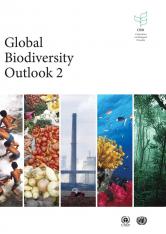Forest Biodiversity
Forest biological diversity is a broad term that refers to all life forms found within forested areas and the ecological roles they perform. As such, forest biological diversity encompasses not just trees, but the multitude of plants, animals and micro-organisms that inhabit forest areas and their associated genetic diversity.
Forest biological diversity can be considered at different levels, including the ecosystem, landscapes, species, populations and genetics. Complex interactions can occur within and amongst these levels. In biologically diverse forests, this complexity allows organisms to adapt to continually changing environmental conditions and to maintain ecosystem functions.
In the annex to decision II/9, the Conference of the Parties recognized that:
“Forest biological diversity results from evolutionary processes over thousands and even millions of years which, in themselves, are driven by ecological forces such as climate, fire, competition and disturbance. Furthermore, the diversity of forest ecosystems (in both physical and biological features) results in high levels of adaptation, a feature of forest ecosystems which is an integral component of their biological diversity. Within specific forest ecosystems, the maintenance of ecological processes is dependent upon the maintenance of their biological diversity.”
For more information on forest biodiversity see Vital Forest Graphics.
Forest biological diversity is broad term referring to all the life forms found within forested areas and the ecological roles they perform. As such, forest biological diversity encompasses not just trees but the multitude of plants, animals and micro-organisms that inhabit forest areas and their associated genetic diversity. More »
In the last 8000 years about 45% of the Earth's original forest cover has disappeared, cleared mostly during the past century. The Food and Agriculture Organization of the United Nations (FAO) recently estimated that about 13 million hectares of the world’s forests are lost due to deforestation each year. The annual net loss of forest area between 2000 and 2005 was 7.3 million hectares (equivalent to the net loss of 0.18 percent of the world’s forests). More »
In the past, timber production was regarded as the dominant function of forests. However in recent years this perception has shifted to a more multi-functional and balanced view. Other forest functions and services, such as recreation, health and well-being, biological diversity, maintenance of ecosystem services and the mitigation of climate change, are now recognized as part of the importance of forests and have become integral components of sustainable forest management. Forest biological diversity is increasingly recognized as both a complex and unique element. More »
The CBD addresses forests directly through the expanded programme of work on forest biological diversity (annex to decision VI/22), adopted in 2002 by the Conference of the Parties at its sixth meeting. The forest work programme constitutes a broad set of goals, objectives and activities aimed at the conservation of forest biodiversity, the sustainable use of its components and the fair and equitable use of the benefits arising from the utilization of forest genetic resources. The programme of work on forest biodiversity consists of three elements: (i) conservation, sustainable use, and benefit-sharing, (ii) institutional and socio-economic enabling environment, (iii) knowledge, assessment, and monitoring. More »
Reducing and/or preventing deforestation is an important mitigation option as the release of carbon as emissions into the atmosphere is prevented. The topic of reducing emissions from deforestation and forest degradation in developing countries was first introduced at the eleventh session of the Conference of the Parties (COP) to the United Nations Framework Convention on Climate Change (UNFCCC) in Montreal (December 2005). More »
Publications
Table headline
| CURABITUR EROS NEQUE | PROIN TINCIDUNT | ALIQUAM |
|---|---|---|
| Curabitur eros neque | Lorem ipsum dolor sit amet, consectetur adipiscing elit. | 654129575 |
| Suspendisse | Maecenas sed justo lorem. Integer sit amet euismod mauris. | 98745465 |
| Curabitur | Maecenas mauris sapien, viverra sed orci vitae, suscipit fermentum nunc. | 235489531 |
| Phasellus egestas | Phasellus egestas commodo odio, eu varius enim porttitor ac. | 2358845641 |
| Nulla facilisi | Nulla sed laoreet arcu. Vestibulum auctor porttitor justo, in lacinia eu. | 321658 |

